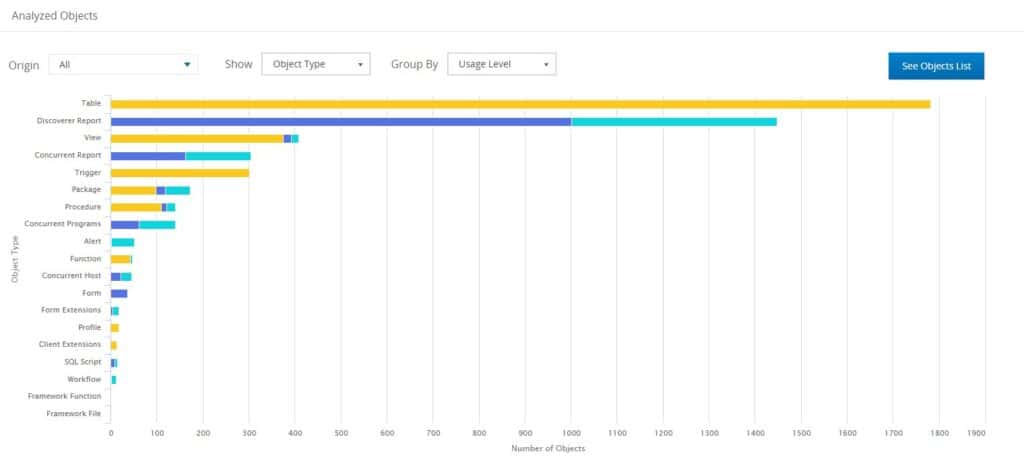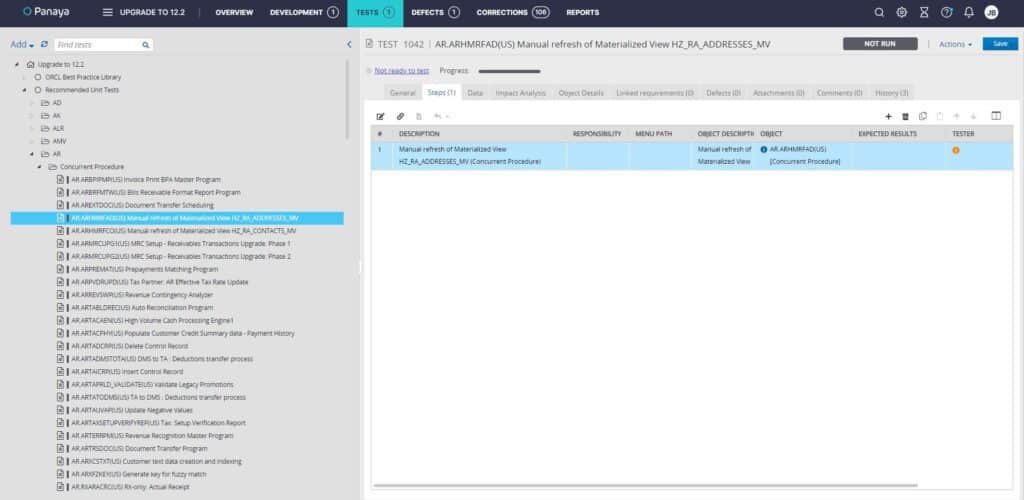Table of Content
What You’ll Learn
- The significance of Oracle EBS R12 in enhancing operational efficiency and customer satisfaction.
- Common performance challenges faced with Oracle EBS R12, including database, application server, front-end, and network issues.
- Best practices for optimizing Oracle EBS R12 performance, such as regular monitoring, database optimization, and process streamlining.
- Strategies for maintaining compliance while optimizing system performance.
- How Panaya’s solution can streamline the Oracle EBS R12 upgrade process, reducing project scope and enhancing visibility.
Understanding the Significance of Oracle EBS R12
In today’s fast-paced business environment, it is crucial for organizations to ensure that their Oracle E Business Suite R12 system is running at peak performance. This not only enhances productivity but also improves customer satisfaction. Understanding the significance of Oracle EBS R12 is the first step towards optimizing its performance.
The significance of Oracle EBS R12 lies in its ability to improve operational efficiency and effectiveness. By automating manual tasks and providing real-time insights, it enables organizations to reduce costs, eliminate errors, and enhance overall productivity. This, in turn, leads to better customer service and increased profitability.
Oracle EBS R12 Performance Challenges
While Oracle E-Business Suite offers robust functionality, users can encounter several performance challenges.
Common Performance Issues in Oracle EBS R12
- Database Performance Challenges: There are two main issues and the first is the change in data volume being processed relative to the time it takes to process, which impacts the response time of a piece of SQL code. Read-only production access is a second challenge which blocks developers from formulating an efficient SQL query. This leads to a large amount of disk reads which then decreases database performance.
- Application Server and Middleware Hurdles: Issues at the application server level, such as poorly optimized code, inadequate server resources (like CPU or memory), or inefficient database access patterns can cause slow response times. The application may consume increasing amounts of memory, leading to performance degradation and potential crashes.
- Front-End Performance Considerations: Performance issues related to the user interface include slow page load times due to heavy web pages, browser incompatibility leading to rendering issues, and inefficient handling of multiple concurrent sessions leading to performance degradation.
- Network and Connectivity Issues: Limited bandwidth can slow down the transmission of data from the server to the client, impacting load times. Additionally, the physical distance between the user and the servers can also increase network latency, affecting response times.
Impact of Poor Performance on Business Operations
Operational Efficiency and User Productivity:
Performance issues can lead to lower operational efficiency as tasks that should take just a few minutes to complete take significantly longer. Prolonged exposure to inefficient work environments can lead to reduced engagement and motivation among employees, as they feel more constrained by the tools at their disposal, thereby reducing productivity.
Cost Implications of Performance Issues
There are both direct and indirect costs associated with poor performance. This starts with increased IT support costs as inefficient systems require more time and resources to achieve the same outcomes. This leads to lost revenue due to downtime, and delayed responses to client queries, directly impacting customer satisfaction.
Risk to Business Continuity and Scalability
Performance challenges can pose risks to business continuity, especially in peak usage periods. Additionally, they can limit the scalability of business operations as they may not be able to handle increased loads effectively.
Best Practices for Oracle EBS R12 Optimization
To fully leverage the benefits of Oracle EBS R12, organizations need to optimize its performance. This involves implementing best practices that ensure smooth and efficient operation of the system. Here are some key practices to consider:
- Monitor system performance regularly
This is essential to identify any bottlenecks or issues that may affect speed and responsiveness. By using monitoring tools and analyzing performance metrics, organizations can proactively address any issues.

- Optimize database performance
This can be achieved by regularly tuning the database, optimizing queries, and implementing proper indexing strategies. Additionally, organizations should ensure that the database server has sufficient resources to handle the workload.
- Streamline business processes
By eliminating unnecessary steps and automating repetitive tasks, organizations can improve efficiency and reduce the load on the system.
- Regularly update and patch the system
Organizations should apply updates in a timely manner to ensure optimal system performance in order to address bugs, security vulnerabilities, and performance issues
- Invest in training and support
Organizations should invest in training their employees and providing ongoing support. This ensures that users are familiar with the system and can effectively utilize its features, which will lead to improved performance and productivity.

Staying Compliant While Optimizing Performance
Organizations need to implement robust security controls and measures, such as strong access controls, encryption, and regular security audits. It is also important to stay up to date with the latest security patches and updates provided by Oracle. Organizations should also educate their employees about security best practices and enforce strong password policies.
Panaya Solution for Oracle EBS R12 Upgrade
Panaya’s solution for Oracle EBS R12 Upgrade is a comprehensive platform that simplifies and streamlines the upgrade process. Organizations can reduce project scope by 80%, through optimizing correction and testing scope, based on your organization’s usage. Businesses will also gain real-time visibility and analysis of customizations throughout the upgrade process. This translates to going live significantly faster as fast, through automatic scoping and built-in collaboration.
So, what’s in it for you?
- A tailor-made, ready-to-execute upgrade project in less than 48 hours
- Customizable dashboards, fully actionable to control each step of your project
- Annotations on impacted code snippets, together with suggested fixes, so your team knows what to do and when to streamline your project, allowing you to go live with zero risk.
Key Takeaways:
- Understanding Oracle EBS R12: Recognize its role in improving operational efficiency and customer satisfaction.
- Performance Challenges: Identify common performance issues in Oracle EBS R12 and their impact on business operations.
- Optimization Best Practices: Implement best practices for regular monitoring, database optimization, and process streamlining.
- Compliance Strategies: Learn how to stay compliant with robust security measures while optimizing performance.
- Panaya Solution Benefits: Discover how Panaya can simplify and expedite the Oracle EBS R12 upgrade process, ensuring a faster and risk-free go-live.
To hear more about our solution, get a demo today.
Get actionable tips & tricks on how to streamline your EBS changes, using today’s AI and automation tools, so you can achieve faster time-to-innovation with zero risk.
